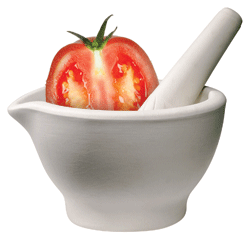Let food be thy medicine; Copper in antimicrobial packaging
CUTTING EDGE TECHNOLOGY
Let food be thy medicine
Greek philosopher Hippocrates’ adage of “Let food be thy medicine and medicine be thy food” may take on new meaning thanks to the application of genetic engineering to food crops. Research is looking at ways to increase the levels of micronutrients (e.g., vitamin A, iron, zinc) or their bioavailability in grains such as rice. Other research, perhaps more intriguing, is exploring the use of genetic engineering to produce crops with components of therapeutic properties or benefit.
One recent example of the latter is recent work by UCLA researchers who have genetically engineered (GE) tomatoes to produce a peptide that mimics the activities of good cholesterol. Published in the April issue of the Journal of Lipid Research, the study (ApoA-I Mimetics: Tomatoes to the Rescue) found that mice that were fed these tomatoes in freeze-dried, ground form had less inflammation and plaque build-up in their arteries.
 “This is one of the first examples of a peptide that acts like the main protein in good cholesterol and can be delivered by simply eating the plant,” said senior author Dr. Alan M. Fogelman, Executive Chair of the Dept. of Medicine at UCLA. “There was no need to isolate or purify the peptide—it was fully active after the plant was eaten.” As preparation for the study, the research team genetically engineered tomatoes to produce 6F, a small peptide that mimics the action of apoA-1, the chief protein in high-density lipoprotein (HDL or “good” cholesterol). Scientists fed the GE tomato product to mice that lacked the ability to remove low-density lipoprotein (LDL or “bad” cholesterol) from their blood. These mice also were prone to developing inflammation and atherosclerosis when consuming a high-fat diet.
“This is one of the first examples of a peptide that acts like the main protein in good cholesterol and can be delivered by simply eating the plant,” said senior author Dr. Alan M. Fogelman, Executive Chair of the Dept. of Medicine at UCLA. “There was no need to isolate or purify the peptide—it was fully active after the plant was eaten.” As preparation for the study, the research team genetically engineered tomatoes to produce 6F, a small peptide that mimics the action of apoA-1, the chief protein in high-density lipoprotein (HDL or “good” cholesterol). Scientists fed the GE tomato product to mice that lacked the ability to remove low-density lipoprotein (LDL or “bad” cholesterol) from their blood. These mice also were prone to developing inflammation and atherosclerosis when consuming a high-fat diet.
The team chose the tomato because it could be eaten without cooking, which may break down the peptide. The researchers were able to successfully genetically express the peptide in tomato plants, and the ripened fruit was then freeze-dried and ground into powder for use in the study.
The researchers discovered that mice that ate the peptide-enhanced tomatoes, which accounted for 2.2% of their Western-style, high-fat diet, had significantly lower levels of inflammation; higher paraoxonase activity, an antioxidant enzyme associated with good cholesterol; higher levels of good cholesterol; decreased lysophosphatidic acid, a tumor-promoter that accelerates plaque build-up in the arteries in animal models; and less atherosclerotic plaque.
After the mice consumed the GE tomato products, the peptide was found to be active in the small intestine but not in the blood. “It seems likely that the mechanism of action of the peptide-enhanced tomatoes involves altering lipid metabolism in the intestine, which positively impacts cholesterol,” said the study’s corresponding author, Srinavasa T. Reddy, a UCLA professor of medicine.
According to Fogelman, if the work in animal models applies to humans, consuming forms of genetically modified foods that contain apoA-1–related peptides could potentially help improve disease-related conditions.
Copper may be useful in antimicrobial packaging
Michigan Technological University scientist Jaroslaw Drelich has discovered how to embed nanoparticles of copper into vermiculite, an inexpensive, inert compound sometimes used in potting soil. In preliminary tests on local lake water, it killed 100% of E. coli bacteria in the sample. Drelich, Professor of materials science and engineering, also found that the mixture was effective in killing Staphylococcus aureus.
Other studies have shown that copper is toxic to Listeria, Salmonella, the antibiotic-resistant bacteria MRSA, viruses, and fungi.
The copper-vermiculite material mixes well with many other materials, such as paperboard and plastic, so it could be used in packing beads, boxes, and cellulose-based egg cartons. If it were incorporated into food packaging materials, it could help prevent a variety of foodborne diseases, Drelich says. Its low cost of 25 cents/lb is also an advantage, affording an inexpensive, effective way to improve the safety of the food supply, especially fruits and vegetables.
Drelich is working with the Michigan Tech SmartZone to commercialize the product through his business, Micro Techno Solutions, Houghton, Mich. He plans further study of the material and to eventually license it to companies that pack fresh food.
If you are working on or know of some cutting edge technology that you would like to be featured in this column, please send an email to [email protected].
